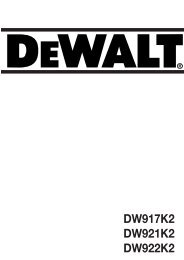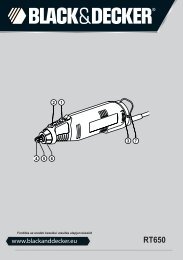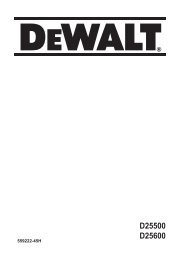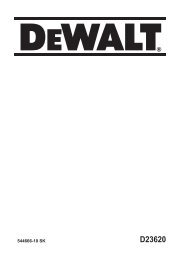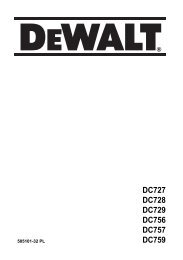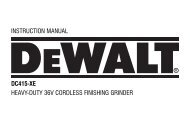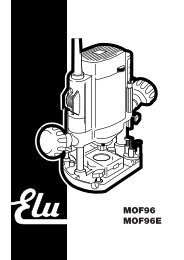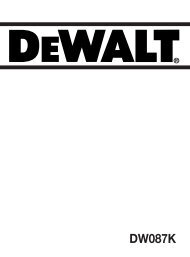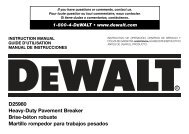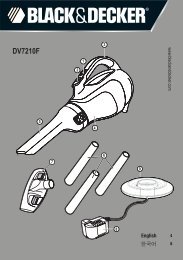Create successful ePaper yourself
Turn your PDF publications into a flip-book with our unique Google optimized e-Paper software.
INSTRUCTION MANUALD28116-XE, D28117-XE, D28133-XE, D28136-XE, D28137-XEHEAVY-DUTY SMALL ANGLE GRINDERS
Definitions: Safety GuidelinesThe definitions below describe the level of severity for each signalword. Please read the manual and pay attention to these symbols.DANGER: Indicates an imminently hazardous situation which, ifnot avoided, will result in death or serious injury.WARNING: Indicates a potentially hazardous situation which, ifnot avoided, could result in death or serious injury.CAUTION: Indicates a potentially hazardous situation which, ifnot avoided, may result in minor or moderate injury.NOTICE: Used without the safety alert symbol indicates apotentially hazardous situation which, if not avoided, may result inproperty damage.IF YOU HAVE ANY QUESTIONS OR COMMENTS ABOUT THIS OR ANY DEWALT TOOL,CALL US AT: 1800 654 155 (Aust) or 0800 339258 (NZ).SAFETY INSTRUCTIONS FOR POWER TOOLSWhen using power tools, always observe the safety regulations applicable in yourcountry to reduce the risk of fire, electric shock and personal injury. Read the followingsafety instructions before attempting to operate this product. Keep these instructions ina safe place.WARNING: To reduce the risk of injury, read the instruction manual.GENERAL SAFETY WARNINGSWARNING! Read all safety warnings and all instructions. Failure to followthe warnings and instructions may result in electric shock, fire and/orserious injury.The term “power tool” in the warnings refers to your mains-operated (corded) powertool or battery-operated (cordless) power tool.SAVE THESE INSTRUCTIONS1) WORK AREA SAFETYa) Keep work area clean and well lit. Cluttered or dark areas invite accidents.b) Do not operate power tools in explosive atmospheres, such as in thepresence of flammable liquids, gases or dust. Power tools create sparkswhich may ignite the dust or fumes.c) Keep children and bystanders away while operating a power tool.Distractions can cause you to lose control.2) ELECTRICAL SAFETYa) Power tool plugs must match the outlet. Never modify the plug in anyway. Do not use any adapter plugs with earthed (grounded) power tools.Unmodified plugs and matching outlets will reduce risk of electric shock.b) Avoid body contact with earthed or grounded surfaces such as pipes,radiators, ranges and refrigerators. There is an increased risk of electricshock if your body is earthed or grounded.c) Do not expose power tools to rain or wet conditions. Water entering a powertool will increase the risk of electric shock.d) Do not abuse the cord. Never use the cord for carrying, pulling orunplugging the power tool. Keep cord away from heat, oil, sharp edgesor moving parts. Damaged or entangled cords increase the risk of electricshock.e) When operating a power tool outdoors, use an extension cord suitablefor outdoor use. Use of a cord suitable for outdoor use reduces the risk ofelectric shock.3) PERSONAL SAFETYa) Stay alert, watch what you are doing and use common sense whenoperating a power tool. Do not use a power tool while you are tired orunder the influence of drugs, alcohol or medication. A moment of inattentionwhile operating power tools may result in serious personal injury.b) Use safety equipment. Always wear eye protection. Protective equipmentsuch as dust mask, non-skid safety shoes, hard hat, or hearing protectionused for appropriate conditions will reduce personal injuries.c) Prevent unintentional starting. Ensure the switch is in the off positionbefore plugging in. Carrying power tools with your finger on the switch orplugging in power tools that have the switch on invites accidents.1
d) Remove any adjusting key or wrench before turning the power tool on. Awrench or a key left attached to a rotating part of the power tool may result inpersonal injury.e) Do not overreach. Keep proper footing and balance at all times. Thisenables better control of the power tool in unexpected situations.f) Dress properly. Do not wear loose clothing or jewellery. Keep your hair,clothing and gloves away from moving parts. Loose clothes, jewellery orlong hair can be caught in moving parts.g) If devices are provided for the connection of dust extraction and collectionfacilities, ensure these are connected and properly used. Use of dustcollection can reduce dust-related hazards.4) POWER TOOL USE AND CAREa) Do not force the power tool. Use the correct power tool for yourapplication. The correct power tool will do the job better and safer at the ratefor which it was designed.b) Do not use the power tool if the switch does not turn it on and off. Anypower tool that cannot be controlled with the switch is dangerous and mustbe repaired.c) Disconnect the plug from the power source and/or the battery pack fromthe power tool before making any adjustments, changing accessories,or storing power tools. Such preventive safety measures reduce the risk ofstarting the power tool accidentally.d) Store idle power tools out of the reach of children and do not allowpersons unfamiliar with the power tool or these instructions to operate thepower tool. Power tools are dangerous in the hands of untrained users.e) Maintain power tools. Check for misalignment or binding of moving parts,breakage of parts and any other condition that may affect the power tool’soperation. If damaged, have the power tool repaired before use. Manyaccidents are caused by poorly maintained power tools.f) Keep cutting tools sharp and clean. Properly maintained cutting tools withsharp cutting edges are less likely to bind and are easier to control.g) Use the power tool, accessories and tool bits etc., in accordance withthese instructions and in the manner intended for the particular type ofpower tool, taking into account the working conditions and the work to beperformed. Use of the power tool for operations different from those intendedcould result in a hazardous situation..5) SERVICEa) Have your power tool serviced by a qualified repair person using onlyidentical replacement parts. This will ensure that the safety of the power toolis maintained.Electrical SafetyThe electric motor has been designed for one voltage only. Always check that thepower supply corresponds to the voltage on the rating plate. 240 V AC means yourtool will operate on alternating current. As little as 10% lower voltage can cause lossof power and can result in overheating. All DEWALT tools are factory tested; if thistool does not operate, check the power supply. Your DEWALT tool is double insulated,therefore no earth wire is required.• Young children and the infirm. This appliance is not intended for use byyoung children or infirm persons without supervision. Young children should besupervised to ensure that they do not play with this appliance.• Replacement of the supply cord. If the supply cord is damaged, it must bereplaced by the manufacturer or an authorised DEWALT <strong>Service</strong> Centre in orderto avoid a hazard.Extension CordsCAUTION: Use only extension cords that are approved by the country’s ElectricalAuthority. Before using extension cords, inspect them for loose or exposed wires,damaged insulation and defective fittings. Replace the cord if necessary.MINIMUM GAUGE FOR CORD SETSFor Cable length (m): 7.5 15 25 30 45 60Use Cable with minimum rating (Amperes)Tool Amperes0 - 3.4 7.5 7.5 7.5 7.5 7.5 7.53.5 - 5.0 7.5 7.5 7.5 7.5 10 155.1 - 7.0 10 10 10 10 15 157.1 - 12.0 15 15 15 15 20 2012.1 - 20.0 20 20 20 20 25 –2
Additional Safety Instructions• Check that the grinding wheel backing flange has a yellow rubber ring (S)installed, see Figure 1. Replace rubber ring if missing, damaged or worn. Seepage 6 for details regarding proper accessory installation.WARNING: The grinding wheel or accessory may loosen during coast-down ofthe tool when shut off if rubber ring is missing or damaged. If grinding wheel oraccessory loosens, it may dismount from the machine and may cause seriouspersonal injury.• Always use proper guard with grinding wheel. A guard protects operator frombroken wheel fragments and wheel contact.• Accessories must be rated for at least the speed recom mended on the toolwarning label. Wheels and other accessories running over rated speed can flyapart and cause injury. Accessory ratings must be above listed minimum wheelspeed as shown on tool nameplate.• Hold tool by insulated gripping surfaces when performing an operationwhere the cutting tool may contact hidden wiring or its own cord. Contactwith a “live” wire will make exposed metal parts of the tool “live” and shock theoperator.• Do not use Type 11 (flaring cup) wheels on this tool. Using inappropriateaccessories can result in injury.• ALWAYS WEAR EYE PROTECTION WHEN USING THIS TOOL.• Use of accessories not specified in this manual is not recommended and maybe hazardous. Use of power boosters that would cause the tool to be driven atspeeds greater than its rated speed constitutes misuse.• Do not use circular saw blades or any other toothed blades with this tool.Serious injury may result.• When starting the tool with a new or replacement wheel, or a new orreplacement wire brush installed, hold the tool in a well protected area andlet it run for one minute. If the wheel has an undetected crack or flaw, it shouldburst in less than one minute. If the wire brush has loose wires, they will bedetected. Never start the tool with a person in line with the wheel. This includesthe operator.• Avoid bouncing the wheel or giving it rough treatment. If this occurs, stop thetool and inspect the wheel for cracks or flaws.• Direct sparks away from operator, bystanders or flammable materials. Sparksmay be produced while cutting and/or grinding. Sparks may cause burns or startfires.• Always use side handle. Tighten the handle securely. The side handle shouldalways be used to maintain control of the tool at all times.• Never cut into area that may contain electrical wiring or piping. Serious injurymay result.• Clean out your tool often, especially after heavy use. Dust and grit containingmetal particles often accumulate on interior surfaces and could create an electricshock hazard.• Do not operate this tool for long periods of time. Vibration caused by theoperating action of this tool may cause permanent injury to fingers, hands, andarms. Use gloves to provide extra cushion, take frequent rest periods, and limitdaily time of use.• Direct the Dust Ejection System TM away from operator and coworkers. Seriousinjury may result (Fig. 1, F).Causes and Operator Prevention of Kickback• Kickback is a sudden reaction to a pinched, bound or misaligned wheel, wirebrush or flap disc causing an uncontrolled cut-off tool to lift up and out of theworkpiece toward the operator.• When the wheel is pinched or bound tightly by the workpiece, the wheel stallsand the motor reaction drives the unit rapidly back toward or away from theoperator.• Kickback is the result of tool misuse and/or incorrect operating procedures orconditions and can be avoided by taking proper precautions as given below:• Maintain a firm grip with both hands on the unit and position your body andarm to allow you to resist kickback forces. Kickback forces can be controlledby the operator, if proper precautions are taken.• When wheel is binding, or when interrupting a cut for any reason, release thetrigger and hold the unit motionless in the material until the wheel comes to acomplete stop. Never attempt to remove the unit from the work or pull the unit3
ackward while the wheel is in motion or kickback may occur. Investigate andtake corrective actions to eliminate the cause of wheel binding.• When restarting a cut-off accessory in the workpiece, check that the wheel isnot engaged into the material. If wheel is binding, it may walk up or kickbackfrom the workpiece as the tool is restarted.• Support large panels to minimize the risk of wheel pinching and kickback.Large panels tend to sag under their own weight. Support must be placed underthe panel on both sides, near the line of cut and near the edge of the panel.WARNING: ALWAYS use safety glasses. Everyday eyeglasses are NOT safetyglasses. Also use face or dust mask if cutting operation is dusty. ALWAYS WEARCERTIFIED SAFETY EQUIPMENT:• ANSI Z87.1 eye protection (CAN/CSA Z94.3),• ANSI S12.6 (S3.19) hearing protection,• NIOSH/OSHA/MSHA respiratory protection.WARNING: Some dust created by power sanding, sawing, grinding, drilling, andother construction activities contains chemicals known to cause cancer, birth defectsor other reproductive harm. Some examples of these chemicals are:• lead from lead-based paints,• crystalline silica from bricks and cement and other masonry products, and• arsenic and chromium from chemically-treated lumber (CCA).Your risk from these exposures varies, depending on how often you do this type ofwork. To reduce your exposure to these chemicals: work in a well ventilated area, andwork with approved safety equipment, such as those dust masks that are speciallydesigned to filter out microscopic particles.• Avoid prolonged contact with dust from power sanding, sawing, grinding,drilling, and other construction activities. Wear protective clothing and washexposed areas with soap and water. Allowing dust to get into your mouth, eyes,or lay on the skin may promote absorption of harmful chemicals.WARNING: Use of this tool can generate and/or disburse dust, which may causeserious and permanent respiratory or other injury. Always use NIOSH/OSHA approvedrespiratory protection appropriate for the dust exposure. Direct particles away fromface and body.WARNING: ALWAYS wear proper personal hearing protection that conforms toANSI S12.6 (S3.19) during use. Under some conditions and duration of use, noisefrom this product may contribute to hearing loss.WARNING Use extra care when working into a corner because a sudden, sharpmovement of the grinder may be experienced when the wheel or other accessorycontacts a secondary surface or a surface edge.WARNING: We recommend the use of a residual current device with a residualcurrent rating of 30mA or less.• The label on your tool may include the following symbols. The symbols and theirdefinitions are as follows:V ................. voltsA ...............amperesHz ............... hertzW ..............wattsmin ............. minutes ...........alternating current.......... direct current ...........alternating or direct current.............. Class I Construction no ..............no load speed................... (grounded) .............earthing terminal............... Class II Construction .............safety alert symbol................... (double insulated) RPM ..........revolutions per minute…/min ........ per minuteBPM ..........beats per minuteIPM ............. impacts per minuteCOMPONENTS (FIG. 1)A. On/off switchB. Spindle lockC. GuardD. Side handle (not shown)E. Electronic variable speed controlF. Dust ejection outletAnti-vibration Side HandleThe anti-vibration side handle(D) offers added comfort by absorbing the vibrationscaused by the tool.4
FIG. 1BD28136-XEEKeyless GuardThe keyless guard (C) allows for quick adjustment during the application to enhanceapplication versatility.Dust Ejection SystemThe dust ejection system prevents dust pile-up around the guard and motor inlet, andminimises the amount of dust entering the motor housing.Soft Start FeatureD28116, D28117, D28133, D28136, D28137The soft start feature allows a slow speed build-up to avoid an initial jerk whenstarting. This feature is particularly useful when working in confined spaces.Electronic Variable Speed ControlD28116, D28117, D28136, D28137The electronic variable speed control (E) offers added tool control and enables the toolto be used at optimum conditions to suit the accessory and material.Autobalance FeatureD28117, D28137The auto balance feature continuously adjusts the balance to reduce the vibration ofthe machine when it is running. This improves user comfort during the operation andis particularly useful when using the machine for long periods of time.ClutchThe torque limiting clutch reduces the maximum torque reaction transmitted to theoperator in case of jamming of a cutting disc. This feature also prevents the gearingand electric motor from stalling. The torque limiting clutch has been factory-set andcannot be adjusted.No-volt Release SwitchThe on/off switch (A) has a no-volt release function. If the power be shut off for somereason, the switch has to be deliberately reactivated.ACEFFSGH5
Overload ProtectionThe power supply to the motor will be reduced in case of motor overload. The powerwill return to normal once the tool has cooled down to suitable operating temperature.ASSEMBLY AND ADJUSTMENTSFIG. 2Attaching Side HandleDThe side handle (D) can be fitted to either side of the gearcase in the threaded holes, as shown. Before using thetool, check that the handle is tightened securely.AccessoriesIt is important to choose the correct guards, backingpads and flanges to use with grinder accessories. Seepages 7–8 for information on choosing the correctaccessories.WARNING: Accessories must be rated for at least the speed recommended on thetool warning label. Wheels and other accessories running over rated accessory speedmay burst and cause injury. Threaded accessories must have a M14x2 hub. Everyunthreaded accessory must have a 22 mm (7/8") arbor hole. If it does not, it mayhave been designed for a circular saw and should not be used. Use only theaccessories shown on pages 7–8 of this manual. Accessory ratings must be abovelisted minimum wheel speed as shown on tool nameplate.GuardWARNING: Turn off and unplug the tool before making any adjustments orremoving or installing attachments or accessories. Before reconnecting the tool,depress and release the paddle switch to ensure that the tool is off.WARNING: Guards must be used with allFIG. 3grinding wheels, sanding flap discs, wire brushes, Kand wire wheels. The tool may be used without aguard only when sanding with conventionalsanding discs. Some DEWALT models areprovided with a guard intended for use withdepressed center wheels (Type 27) and hubbed grinding wheels (Type 27). The sameguard is designed for use with sanding flap discs (Type 27 and 29) and wire brushes.Grinding and cutting with wheels other thanType 27 and 29 require different accessory guards not included with tool. Mountinginstructions for these accessory guards are included in the accessory package.MOUNTING AND REMOVING GUARDD28116, D28133, D281361. Open the guard latch (J). Align the lugs (K)FIG. 4on the guard with the slots (L) on the gear case.2. Push the guard down until the guard lugs engageand rotate freely in the groove on the gear case hub.3. With the guard latch open, rotate the guard (C) intothe desired working position. The guard body shouldbe positioned between the spindle and the operator toprovide maximum operator protection.4. Close the guard latch to secure the guard on the gearCcase. You should not be able to rotate the guard byhand when the latch is closed. Do not operate thegrinder with a loose guard or the clamp lever in open position.5. To remove the guard, open the guard latch, rotate the guard so that the arrowsare aligned and pull up on the guard.FIG. 5NOTE: The guard is pre-adjusted to the diameter of thegear case hub at the factory. If, after a period of time,the guard becomes loose, tighten the adjusting screw(M) with clamp lever in the closed position.CAUTION: If guard cannot be tightened by adjusting Mclamp, do not use tool and take the tool and guard toa service center to repair or replace the guard.NOTICE: Do not tighten the adjusting screw with theclamp lever in open position. Undetectable damage to the guard or the mounting hubmay result.LJ6
Type 27 guardbacking flangeType 27 depressedcenter wheelthreaded clamp nutType 27 guard75 mm (3")wire cup brushGrinding WheelsWire WheelsType 27 guardType 27 hubbed wheelType 27 guard100 mm (4")wire wheelMOUNTING AND REMOVING GUARD FIG. 6D28117, D28137R1. Remove fasteners.2. Proceed as previously described to slideQguard past the spindle.3. Replace the fasteners.P4. Clamp the guard as previously described.Fitting and Removing a Grinding orNCutting Disc (fig. 1, 6, 7)1. Place the tool on a table, guard up.O2. Fit the inner flange (N) correctly onto thespindle (O) (fig. 6).B3. Place the disc (P) on the flange (N). Whenfitting a disc with a raised center, make surethat the raised centre (Q) is facing the flangeFIG. 7(N).4. Screw the outer flange (R) onto the spindle(O) (fig. 7):– the ring on the flange (R) must face towardsthe disc when fitting a grinding disc (Fig. 7A);– the ring on the flange (R) must face awayfrom the disc when fitting a cutting disc A(Fig. 7B).5. Press the spindle lock (B) and rotate the spindle(O) until it locks in position.6. Tighten the flange (R) with the two-pin spannersupplied.7. Release the spindle lock.To remove the disc, loosen the flange (R) with the twopinspanner.BWARNING: Do not use a damaged disc.RPNORPNO7
Cutting WheelsSanding DiscsSanding Flap DiscsType 1 guardType 1 guardrubber backing padType 27 guardType 27 guardbacking flangebacking flangesanding dischubbed sandingflap discbacking flangeabrasive cutting wheeldiamond cutting wheelthreaded clamp nutnon-hubbedsanding flap discclamp nutclamp nutthreaded clamp nutSetting the Electronic Speed Control (fig. 1)D28116, D28117, D28136, D28137Turn the dial (E) to the desired level. Turn the dial upwards for higher speed anddownwards for lower speed. The required setting is a matter of experience.E.g.:– when cutting in soft, brittle materials, set the dial to a low setting;– when cutting in harder materials, set the dial to a high setting.OPERATIONWARNING: Ensure all materials to be ground or cut are secured in place.WARNING: Avoid overloading. Should the tool become hot, let it run a few minutesunder no load condition. Apply only a gentle pressure to the tool.WARNING: Do not exert side pressure on the disc.Guards and FlangesIt is important to choose the correct guards and flanges to use with the grinderaccessories. See pages 7–8 for the correct accessories.NOTE: Edge grinding and cutting can be performed with Type 27 wheels designedand specified for this purpose.WARNING: Accessories must be rated for at least the speed recommended on thetool warning label. Wheels and other accessories running over rated accessory speedmay burst and cause injury. Every unthreaded accessory must have a 22 mm (7/8")arbor hole. If it does not, it may have been designed for a circular saw and should notbe used. Use only the accessories shown on pages 7–8. Accessory ratings must beabove listed minimum wheel speed as shown on tool nameplate.8
SwitchesWARNING: Hold the side handle and body of the tool firmly to maintain control ofthe tool at start up and during use and until the wheel or accessory stops rotating.Make sure the wheel has come to a complete stop before laying the tool down.WARNING: Before connecting the tool to a power supply, be sure the switch is inthe off position by pressing the rear part of the switch and releasing. Ensure theswitch is in the off position as described above after any interruption in power supplyto the tool, such as the activation of a ground fault interrupter, throwing of a circuitbreaker, accidental unplugging, or power failure. If the switch is locked on when thepower is connected, the tool will start unexpectedly.NOTE: To reduce unexpected tool movement, do not switch the tool on or off whileunder load conditions. Allow the grinder to run up to full speed before touching thework surface. Lift the tool from the surface before turning the tool off. Allow the toolto stop rotating before putting it down.To run the tool, press the on/off switch (A).For continuous operation, press the switch completely forward.To stop the tool, release the switch.To stop the tool in continuous operation, press on the back part of the switch.Spindle LockThe spindle lock (B) is provided to prevent the spindleFIG. 8from rotating when installing or removing wheels. OperateBthe spindle lock only when the tool is turned off,unplugged from the power supply, and has come to acomplete stop. Do not engage the spindle lock while thetool is operating because damage to the tool will result. Toengage the lock, depress the spindle lock button androtate the spindle until you are unable to rotate the spindlefurther.Surface Grinding with Grinding Wheels1. Allow the tool to reach full speed before touching the tool to the work surface.2. Apply minimum pressure to the work surface, allowing the tool to operate at highspeed. Grinding rate is greatest when the tool operates at high speed.3. Maintain a 20˚ to 30˚ angle between the tool and FIG. 9work surface.4. Continuously move the tool in a forward andback motion to avoid creating gouges in the work20˚-30˚surface.5. Remove the tool from work surface before turningtool off. Allow the tool to stop rotating before laying it down.FIG. 10Edge Grinding with Grinding WheelsCAUTION: Wheels used for cutting and edge grindingmay break if they bend or twist while the tool is beingused to do cut-off work or deep grinding. To reduce therisk of serious injury, limit the use of these wheels with astandard Type 27 guard to shallow cutting and notching[less than 13 mm (1/2") in depth]. The open side of theguard must be positioned away from the operator. Fordeeper cutting with a Type 1 cut-off wheel, use a closed,Type 1 guard. See the chart on page 8 for moreinformation. Type 1 guards are available at extra costfrom your local dealer or authorized service center.1. Allow the tool to reach full speed before touchingthe tool to the work surface.2. Apply minimum pressure to the work surface, allowing the tool to operate at highspeed. Grinding rate is greatest when the tool operates at high speed.3. Position yourself so that the open-underside of the wheel is facing away fromyou.4. Once a cut is begun and a notch is established in the workpiece, do not changethe angle of the cut. Changing the angle will cause the wheel to bend and maycause wheel breakage. Edge grinding wheels are not designed to withstand sidepressures caused by bending.5. Remove the tool from the work surface before turning the tool off. Allow the toolto stop rotating before laying it down.WARNING: Do not use edge grinding/cutting wheels for surface grindingapplications because these wheels are not designed for side pressures encounteredwith surface grinding. Wheel breakage and injury may result.9
Mounting and Using Cutting (Type 1) WheelsCutting wheels include diamond wheels and abrasive discs. Abrasive cutting wheelsfor metal and concrete use are available. Diamond blades for concrete cutting canalso be used.WARNING: A closed, 2-sided cutting wheel guard is not included with this tool butis required when using cutting wheels. Failure to use proper flange and guard canresult in injury resulting from wheel breakage and wheel contact. See page 8 for moreinformation.FIG. 11 LMOUNTING CLOSED (TYPE 1) GUARDWARNING: Turn off and unplug the tool beforemaking any adjustments or removing or installingattachments or accessories. Before reconnectingthe tool, turn the switch on and off as previouslydescribed to ensure that the tool is off.K1. Open the guard latch (J). Align the lugs (K) onthe guard with the slots (L) on the gear case.J2. Push the guard down until the guard lug engages FIG. 12and rotates freely in the groove on the gear casehub.3. Rotate guard (C) into desired working position.The guard body should be positioned betweenthe spindle and the operator to provide maximumoperator protection.4. Close the guard latch to secure the guard on theCgear case cover. You should be unable to rotate theguard by hand when the latch is in closed position.FIG. 13If rotation is possible, tighten the adjusting screw (M)with clamp lever in the closed position. Do notoperate grinder with a loose guard or clamp lever inopen position.M5. To remove the guard, open the guard latch, rotate theguard so that the arrows are aligned and pullup on the guard.NOTE: If, after a period of time, the guard becomes loose, tighten the adjusting screw(M) with the clamp lever in the closed position.CAUTION: Do not tighten adjusting screw with clamp lever in open position.Undetectable damage to guard or mounting hub may result.MOUNTING CUTTING WHEELSWARNING: Turn off and unplug the tool before making any adjustments orremoving or installing attachments or accessories. Before reconnecting the tool,turn the switch on and off as previously described to ensure that the tool is off.CAUTION: Matching diameter unthreaded backing flange and clamp nut (includedwith tool) must be used for cutting wheels.1. Place the unthreaded backing flange on spindle with the raised section (pilot)facing up. The raised section (pilot) on the backing flange will be against thewheel when the wheel is installed.2. Place the wheel on the backing flange, centering the wheel on the raised section(pilot).3. Install the threaded clamp nut with the raised section (pilot) facing away from thewheel.4. Depress the spindle lock button and tighten clamp nut with a wrench.5. To remove the wheel, grasp and turn while depressing the spindle lock button.USING CUTTING WHEELSWARNING: Do not use edge grinding/ cutting wheels for surface grindingapplications because these wheels are not designed for side pressures encounteredwith surface grinding. Wheel breakage and injury may result.1. Allow tool to reach full speed before touching tool to work surface.2. Apply minimum pressure to work surface, allowing tool to operate at high speed.Cutting rate is greatest when the tool operates at high speed.3. Once a cut is begun and a notch is established in the workpiece, do not changethe angle of the cut. Changing the angle will cause the wheel to bend and maycause wheel breakage.4. Remove the tool from work surface before turning tool off. Allow the tool to stoprotating before setting it down.10
Metal ApplicationsWhen using the tool in metal applications, make sure that a residual current device(RCD) has been inserted to avoid residual risks caused by metal swarf.If the power supply is shut off by the RCD, take the tool to authorised DEWALT repairagent.WARNING: In extreme working conditions, conductive dust can accumulate insidethe machine housing when working with metal. This can result in the protectiveinsulation in the machine becoming degraded with a potential risk of an electricalshock.To avoid build-up of metal swarf inside the machine, we recommend to clear theventilation slots on a daily basis. Refer to Cleaning under Maintenance for moreinformation.Using Flap DiscsWARNING: Shock hazard. Metal dust build-upExtensive use of flap discs in metal applications can result in the increased potentialfor electric shock. To reduce this risk, insert an RCD before use and clean theventilation slots daily by blowing dry compressed air into the ventilation slots inaccordance with the below maintenance instructions.MAINTENANCEWARNING: To reduce the risk of serious personal injury, turn tool off anddisconnect tool from power source before making any adjustments or removing/installing attachments or accessories.Pop-off BrushesThe motor will be automatically shut off indicating that the carbon brushes arenearly worn out and that the tool needs servicing. The carbon brushes are notuser-serviceable. Take the tool to an authorised DEWALT repair agent.CleaningWARNING: Blow dirt and dust out of all air vents with dry air at least once a week.Wear proper ANSI Z87.1 (CAN/CSA Z94.3) eye protection and proper NIOSH/OSHA/MSHA respiratory protection when performing this.Blowing dust and grit out of motor and switch actuator using clean, dry compressedair is a necessary regular maintenance procedure. Dust and grit containing metalparticles often accumulate on interior surfaces and could create an electrical shockor electrocution if not frequently cleaned out. It is recommended that a ground faultcircuit interrupter (GFCI) is utilized to further protect the user from electric shockresulting from the accumulation of conductive particles. If the tool is deactivated bythe GFCI, unplug the tool and check and clean the tool before resetting the GFCI. Wearproper ANSI Z87.1 (CAN/CSA Z94.3) eye protection and proper NIOSH/OSHA/MSHArespiratory protection when performing this.WARNING: Never use solvents or other harsh chemicals for cleaning the nonmetallicparts of the tool. These chemicals may weaken the plastic materials used inthese parts. Use a cloth dampened only with water and mild soap. Never let any liquidget inside the tool; never immerse any part of the tool into a liquid.LubricationDEWALT tools are properly lubricated at the factory and are ready for use.RepairsTo assure product SAFETY and RELIABILITY, repairs, maintenance and adjustment(including brush inspection and replacement) should be performed by certifiedservice centers or other qualified service organizations, always using identicalreplacement parts.ACCESSORIESWARNING: Since accessories, other than those offered by DEWALT, have not beentested with this product, use of such accessories with this tool could be hazardous.To reduce the risk of injury, only DEWALT, recommended accessories should be usedwith this product.Recommended accessories for use with your tool are available at extra cost fromyour local service center. If you need any assistance in locating any accessory,please contact DEWALT Industrial Tool Co., 20 Fletcher Road, Mooroolbark, VIC 3138<strong>Australia</strong> or call 1800 654 155 or (NZ) 0800 339258.11
GuaranteeApplicable to hand held Power Tools, Lasers and Nailers.Three Year Limited WarrantyDEWALT will repair, without charge, any defects due to faulty materials orworkmanship for three years from the date of purchase. Please return the completeunit, transportation prepaid, to any DEWALT <strong>Service</strong> Centre, or any authorisedservice station.For warranty repair information, call (AUS) 1800 654 155 or (NZ) 0800 339258.This warranty does not apply to• Accessories• Damage caused where repairs have been made or attempted by others.• Damage due to misuse, neglect, wear and tear, alteration or modification.This warranty gives you specific legal rights and you may have other rights under theprovisions of the Consumer Guarantee Act 1993 (<strong>New</strong> <strong>Zealand</strong> only), Trade PracticesAct 1974 and State Legislation (<strong>Australia</strong> only).In addition to the warranty, DEWALT tools are covered by our:FREE ONE YEAR SERVICE CONTRACTDEWALT will also maintain the tool for free at any time during the first year ofpurchase. This includes labour, parts and lubrication required to restore the product tosound mechanical and/or electrical condition. Normal wear parts are not covered inthis service. Carbon brushes worn more then 50% will be replaced.NOTE: Three Year Warranty is not applicable to items deemed as consumables. Radialarm saws are covered by a one (1) year warranty only. DEWALT Reserves the right toreview its warranty policy prior to launch of any new business development products.30 DAY NO SATISFACTION GUARANTEEIf you are dissatisfied with any DEWALT power tool, laser or nailer, for any reason,simply return it to the point of purchase with your sales receipt within 30 days for areplacement unit or a full refund.FREE WARNING LABEL REPLACEMENT: If your warning labels become illegible orare missing, call (AUS) 1800 654 155 or (NZ) 0800 339258 for a free replacement.12
DEWALT Industrial Tool Co.,20 Fletcher Road, Mooroolbark, VIC 3138 <strong>Australia</strong> (03 8720 5100) • 5 Te Apunga Place, Mt Wellington, <strong>New</strong> <strong>Zealand</strong> (0800 339258)(OCT09) Part No. N043524 D28116-XE, D28117-XE, D28133-XE, D28136-XE, D28137-XE Copyright © 2009 DEWALTThe following are trademarks for one or more DEWALT power tools: the yellow and black color scheme; the "D" shaped air intake grill; the array of pyramids on the handgrip;the kit box configuration; and the array of lozenge-shaped humps on the surface of the tool.




